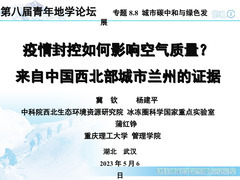报告详情
How Does COVID-19 Lockdown Affect Air Quality: Evidence from Lanzhou, a large city in Northwest China
编号:3335
访问权限:私有
更新:2023-04-14 14:41:51 浏览:700次
口头报告
摘要
Coronavirus disease (COVID-19) has disrupted health, economy, and society globally. Thus, many countries, including China, have adopted lockdowns to prevent the epidemic, which has limited human activities while affecting air quality. These affects have received attention from academics, but very few studies have focused on western China, with a lack of comparative studies across lockdown periods. Accordingly, this study examines the effects of lockdowns on air quality and pollution, using the hourly and daily air monitoring data collected from Lanzhou, a large city in Northwest China. The results indicate an overall improvement in air quality during the three lockdowns compared to the average air quality in the recent years, as well as reduced PM2.5, PM10, SO2, NO2, and CO concentrations with different rates and increased O3 concentration. During lockdowns, Lanzhou’s “morning peak” of air pollution was alleviated, while the spatial characteristics remained unchanged. Further, ordered multi-classification logistic regression models to explore the mechanisms by which socioeconomic backgrounds and epidemic circumstances influence air quality revealed that the increment in population density significantly aggravated air pollution, while the presence of new cases in Lanzhou, and medium- and high-risk areas in the given district or county both increase the likelihood of air quality improvement in different degrees. These findings contribute to the understanding of the impact of lockdown on air quality, and propose policy suggestions to control air pollution and achieve green development in the post-epidemic era.
关键词
COVID-19 lockdown, change of air quality, Lanzhou of China, post-epidemic era, policy implications
报告人

冀钦
中国科学院西北生态环境资源研究院稿件作者
全部评论
重要日期
-
会议日期
05月05日
2023
至05月08日
2023
-
03月31日 2023
初稿截稿日期
-
05月25日 2023
注册截止日期
主办单位
青年地学论坛理事会
中国科学院青年创新促进会地学分会
中国科学院青年创新促进会地学分会
承办单位
武汉大学
中国科学院精密测量科学与技术创新研究院
中国地质大学(武汉)
中国科学院精密测量科学与技术创新研究院
中国地质大学(武汉)



发表评论